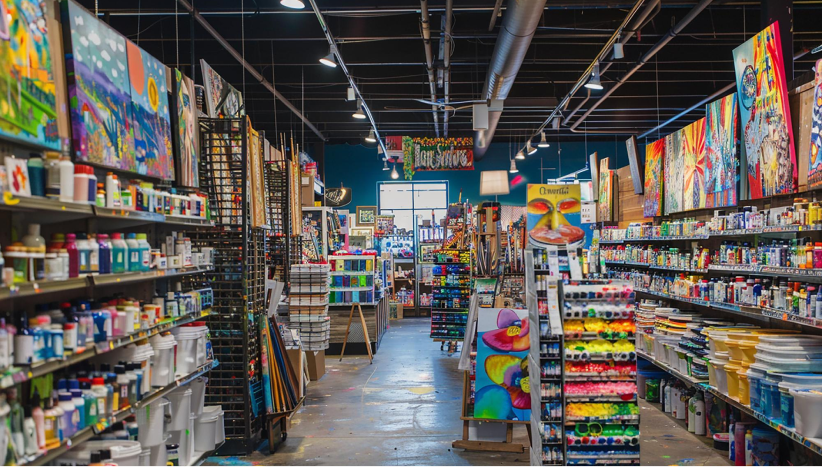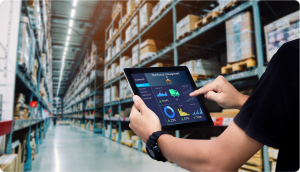
Have you ever wondered how big retailers like Walmart and Costco manage to have the right products and merchandise on display? How do they always keep their aisles and counters stocked up with as per demand fluctuations and product shelf-life? Lately, the answer is AI’s advanced data analytics!
A well-thought-out and strategic product placement is crucial for retail and consumer packaged goods (CPG) companies to grab customers’ attention and manage space constraints. In 2025, AI product placement will be a leg-up for optimizing in-store shelf space and product exposure to influence buying to drive sales and brand visibility.
In this blog, we will explore the science behind strategic product placement and the merits of incorporating data-driven placement optimization using AI.
The Visual Appeal of Product Placement: Why it’s Important for Retail and CPG Businesses?
In a layperson’s definition, product placement refers to physically placing retail products and goods across the store shelves and displays in a way that:
- Enhances product visibility and exposure
- Influences consumers buying decisions
- Maximizes in-store layout and space
- And boosts brand awareness and loyalty
At the point of purchase, brands strive to attract customers and impact their buying decisions using a mix of strategies and approaches. Typically, they involve placement of the product at eye level, presentation of the brand name, logo and symbols, signage, product labels, attractive packaging, and promotional messages.
Strategic product placement proves the importance of visual appeal. NeilsenIQ shopper research’s meta-analysis of 15 classifications and 155 brands concluded that sales were driven by product availability and visibility. It also revealed that for products that customers were most likely to buy on impulse, and also placement on shelves and outside the store resulted in incremental sales.
Another study of over 3,000 participants found that 82% of shoppers made purchase decisions in-store, 62% indulged in impulse shopping, and 16% of unplanned purchases were influenced by in-store product promotions.
Online stores and e-commerce platforms mushroomed at the peak of the COVID-19 pandemic in 2020. Brick-and-mortar retail stores must go the extra mile to compete with digital retail platforms by keeping steady footfall and in-store purchases. Product placements are powerful tools to reach target customers and hit the ‘sweet spot’ to drive sales. Below are some facts about customer psychology that brands need to consider charting for strategic product placement:
![]()
Consumers walk into the store looking for products
Customers visit in-store when there is a need for a product like cheese or fabric softener, not a specific brand. When they see the products of a brand they recognize or are loyal to, they are likely to purchase them. However, Havas’ Meaningful Brand Survey reveals brand preference does not necessarily dictate customers’ shopping decisions.
![]()
In-store experience impacts buyers’ behavior
Almost 82% of customers make their purchase decisions in-store.
![]()
Deals and offers sway consumers
About 70% of customers look for a minimum discount of up to 30%: loyalty programs, points, cashbacks, and discounts after a purchase impact 95% of shopping decisions.
![]()
Shoppers’ dilemmas are real
Customers want to simplify their search and make a decision when it comes to choosing the right product. Brand and product placements with a tailored message on how to solve a problem or address a specific need succeed in helping them choose.
![]()
Consumers are value-conscious
Most shoppers keep track of the pricing of household and retail products. According to Forbes Reports, close to 41% of customers feel that brands and retail companies must control price increases and fluctuations. They are more likely to look for alternative stores and brands to reduce costs.
![]()
Consumers remember in-store ads
Traditional in-store promotions and advertisements in signage, standees, and posters make brands and products memorable. Brand recall impacts 69% of product browsing and 61% of purchases, confirms the Forbes study.
Strategic Product Placement is More Than Intuitive Display
Retail and CPG businesses have problems beyond arranging goods and inventory to induce the urge to shop. These include optimizing space for eye-level display and shelving, cross-brand and product bundling, season—and trend-based store arrangements, inventory balance, and real-time sales tracking.
In today’s hyper-digital age, businesses must compete with rivals and their online versions. Product placement would be mere purposeless guesswork without relevant and timely data insights!
Barriers to Successful Product Placement and Optimization:
Let’s unpack common hurdles to effective product placement and optimization
Customer Intelligence
A 360-degree overview of customers’ demographics, preferences, expectations, and behavior is a cornerstone of an actionable and data-driven product placement strategy. It helps analyze customer data throughout the journey to understand short-term and long-term trends, customer churn, in-store visits, and engagement patterns.
No Data, No Direction
Lack of in-depth data can create blind spots in understanding customer expectations, behavior, and personas for deciding the ideal placement of products. Without data-driven insights, it is impossible to track and benchmark performance, customer footfall, inventory and store space usage, sales, customer-brand engagement, and satisfaction.
Poor Place Equals Multiple Losses
Poor decisions without data-backed evidence and relevant performance metrics often lead to poor product and brand visibility. The losses include reduced sales, inventory, resources, and space wastage, as well as several missed opportunities for stores to leverage direct customer interactions and brand promotional strategies.
Unpredictability of Trends and Customers’ Behaviors
Understanding variations in customer behaviors and demands and location—and region-specific trends helps unlock a treasure trove of data to increase in-store purchases and customer loyalty. The absence of predictive insights is a significant barrier to tailoring product placement strategies based on trends and trajectories that vary across stores and regions.
On-shelf Competition
Battling competitors to win customers’ attention is the ultimate goal of every retail and CPG brand looking to capture sales. Intense market competition and dynamic trends in digital shopping leave too little room for innovation strategies in product placements.
Imbalance of Inventory and Shelf Space
High visibility is achieved with the effective use of the store layout to create impactful first impressions. Space planning and arrangement also depend on judicious balancing inventory. Balancing available product or inventory levels with available shelf space is not a beginner’s task.
Large retail and CPG businesses have ample resources and funds to test and execute elements of a well-defined product placement strategy. Smaller stores without bandwidth cannot afford to make their in-store layout and appearance an afterthought. We have listed some time-tested methods that help capitalize on in-store product placement for effective advertising, brand promotions, and sales performance.
Proven Strategies for Product Placement Optimization:
Strategic Shelving & Display Techniques
Beyond just stacking products in rows and aisles, retail stores select the ideal shelving and display tactic within the available space as per visitor flow, customer movements, high-engagement, and common constraints.
POS (Point-of-Sale) Displays
Customers will always have last-minute requirements and purchases, thanks to their tendency to engage in impulse shopping. Positioning products of high to low utility at the billing counters works as effective reminders to customers about the products they may require.
End Cap Displays
The high-visibility placements of products and brand promotion messages at the end of aisles drive customer actions while also optimizing self or store space and guaranteeing a leg up on the competition.
Vertical vs. Horizontal Placement
When eye-level is the “buy-level”, brands choose vertical placement or horizontal placement strategies for rack space utilization. Vertical placements involve positioning similar products in a way it provides a top-down/vertical view. Horizontal placements involve linear placement of similar products across the shelf or aisle to draw shoppers’ attention. Both these strategies have their own merits like facilitating buyers to browse products and make purchase decisions while moving across long aisles and sections or standing at one position to check vertical displays.
Planogram Optimization
Planograms are detailed visual maps of product and merchandise placements and displays. It provides an overview of the store, aesthetics and insights for ideal layouts to prevent over and under-stocking of products, store overcrowding, movement barriers, and consistency across the store for brand and product visibility. AI-driven planograms to enhance shelf layouts in ways that guarantee sales and build a connection with the customers.
Trend & Seasonal-Based Placement
Managing product inventory and distribution across the store according to demand fluctuations and season spikes supports in-store customers and closes gaps in product accessibility. It helps accurately predict the type and volume of products required for display, along with personalized offers and discounts.
Competitor Benchmarking
It is important to keep an eye and ear out for what makes brand competitors unique. Competitor benchmarking helps one think beyond cookie-cutter approaches and stay updated with current product placement trends to earn an edge.
Data-Driven Placement Optimization
Leveraging AI and advanced data analytics is the key to successful brands’ product positioning and sales strategies. From creating first impressions, unlocking customer data, managing inventory and supply chain, and heat mapping to tracking shopper movements, valuable data is behind determining high-impact placement zones. Data-driven platforms with built-in AI and predictive insights help with A/B testing and regular performance tracking to spot unusual trends that help uncover unique opportunities.
AI Product Placement Can Be a Game-changer
According to a study published in the Journal of Marketing, well-designed store displays increase sales by 540%. In-store branding has unmissable factors facilitating long-lasting customer relationships and opportunities to visualize and demonstrate brand values through displays and layouts. 88% of global shoppers prefer physical stores that engage their senses!
Global AI spending in the retail industry is estimated to reach $31.18 billion by 2028. With tech investment booms embedded in marketing and customer loyalty, global spending on AI for strategic product placement is meant to surge in 2025. Walmart, Target, and Costco are retail giants with relatively mature tech initiatives. Their AI-powered tools and projects solve everyday business problems involving grocery and merchandise stocking, waste reduction, and observing customers’ in-store shopping behavior in real time.
Here are some of AI-led platform capabilities that can be leveraged to create unique in-store experiences through strategic product placements:
1. AI-Powered Planograms
Preview and tweak shelf layouts, display sections, product bundling, inventory, and supply chain planning before rolling them out to physical stores. AI-generated simulations and planograms help visualize layout design and placement strategies based on historical sales data and customer preferences to reduce costly errors and inventory wastage.


2. Computer Vision for Foot Traffic Analysis
Leverage footfall analytics and visitor movement in real-time to understand high-engagement zones across the stores. AI-led platforms with real-time analytics and dynamically trained ML models help convert visual data to meaningful insights, dwell time, average visitor count, and more.
3. Predictive Analytics
Comprehensive analysis of historic data, peak hours, slow days, areas of high and low engagements, demand fluctuations, and anomalies not only predicts future scenarios but also recommends ideal placement strategies.


4. Automated A/B Testing
Using AI to test and refine placement in real-time and record valuable learnings from A/B testing enables understanding variants across touchpoints, comparing results, and adjusting strategies.
5. Dynamic Placement Adjustments
During peak season and unexpected customer flow, AI-driven tools help monitor and optimize store location, avoid wait time, overcrowding, and understocking, and reallocate resources and personnel in real-time to serve customers and impact sales.


6. Personalized Product Recommendations
The race for personalization is powered by digital signage and interactive displays suggesting relevant products based on customer demographics.
Industry-Specific Use Cases of Strategic Product Placement and Optimization
Apparel & Retail Fashion
We have often heard of common tactics like positioning mirrors across a retail store to encourage trials and tryouts to increase the possibility of sales. Cross-merchandising, or placing complementary products and merchandise together, like jewelry and cosmetics alone in supermarkets near clothing sections, is standard across shopping malls, retail conglomerates, and beauty brands like Sephora, Macy’s, Target, etc.
Supermarkets & Grocery Stores
Supermarkets and grocery stores often place everyday household products that are high-margin at eye level or bundle them together to cater to demand and drive sales. Often, grocery and retail stores bundle products together to influence bulk purchases or the buying of complementary items like cheese, meat, and condiments near bread.
Sports & Outdoor Stores
Most sportswear, outdoor, and athleisure brands place trending or high-demand gear near the store entrance or display sections to create a sense of urgency among shoppers to buy before the trend wears out and stock runs out. Sportswear and clothing brands make optimal use of displays to suggest the latest trends and visually appeal to buyers.
Automotive & Accessories Stores
Most vehicle and automotive deals include essential add-ons and accessories like protective gears, tires, and insurance during the billing stage or right at the checkout counters.
Convenience Stores
Your neighborhood mom-and-pop shop also leverages cross-promotional placements across sections and arranges fast-moving products near entry areas of the store for high visibility and sales.
Conclusion
In 2024, Americans spent $7 trillion on in-store shopping compared to $1 trillion on online shopping. In-store shopping may remain traditional, but consumers expect novelty in experiences. Ending legacy IT strategies and embracing solutions and tools based on AI, GenAI, computer vision, and sensor technologies helps transform retail operations for intelligent customers, product, and sales analysis. Technology providers collaborate with retail companies to rethink operations and build a unified approach to a human-centric in-store experience.
AI and data analytics platforms have reached stages beyond initial testing and will likely become the norm in product placement strategy refining. With continuous optimization through experimentation and customer insights, brands have addressed the ‘whys’ in retail and in-store planning. AI and automation are jointly slated to remove redundancies across the retail journey, manual and repetitive efforts, and error-ridden product placement planning and execution.
Are you ready to test AI solutions for your products?
Discover possibilities using AI capabilities with iTech’s innovative solutions and services.
Talk to our experts now!







